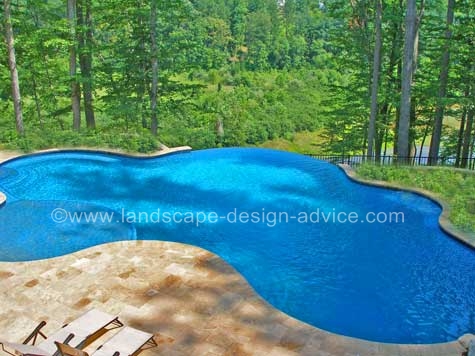Travertine Stone Pavers
Differences Between Honed, Filled and Tumbled
Which type of travertine stone should I buy?
Travertine stone is a natural stone mined in many countries. Depending on where the stone comes from, the quality may be better or worse. In addition, there are certain processes sometimes performed to improve the look.
If you
are interested in travertine pavers and have been doing any research (or
if this is your first stop), there are various terms you might have
come across. It can be quite confusing as to what the differences.
Travertine Pavers Pool Decking

What is the best type of travertine stone? The answer to this is that it really depends on the look you want.
Here is an explanation of various types and terms in hopes of clarifying the confusion.
Honed Travertine Stone (Polished)
When you hear the term honed, this refers to polishing or sanding the pavers.
- If it is a good quality stone, just a minimal amount of this is needed.
- The appearance of lower grade travertine will improve by polishing more layers, resulting in a smoother looking travertine stone where holes, nooks and crannies are reduced.
- Honed stone may or may not be filled.
Filled Travertine
Existing holes are filled, often with a grout. Can you see the fillings? Yes, if you look closely, but basically it is not noticeable, unless there are lots and lots of holes or they are on the large size.
Filling the holes creates a smoother look. So you can have stone that is just filled (not honed), or perhaps honed slightly and filled.
Tumbled Travertine
Natural travertine, typically not honed or filled, is tumbled in a similar way that tumbled pavers are. Many holes are present. The edges and corners are rough and/or wavy. The travertine has an overall "rough" look.
Different
companies perform different amounts of sanding. This is why travertine
pavers from no two companies are the same, and you must know what you
are buying.
Choose top grade travertine pavers.
How do you know if it the travertine you are considering is of
high quality? You can see for yourself, so get samples!!
Also, visit my page on travertine stone sealers to read about if you should use one and what kind.
My Travertine Buying Guide
So which is best and which should you look for? The following is a guide:
Tumbled Pavers
If you like the look of unfinished stone, consider the tumbled pavers. Be aware that the holes that are there will be numerous. Polymeric sand (great article), sand or stonedust should be swept into the joints, but this will be more noticeable than when installing travertine pavers that are not tumbled, due to the uneven edges.
Some people are concerned with the holes filling with dirt over time if they install a travertine patio or pool decking. I would not worry about this as it shouldn't be that noticeable and the travertine can be power washed. The holes will, however, fill with water after a rain.
I know this for sure. I once had a client who purchased travertine pavers that were tumbled, against my advice. I went to see it after it had just rained, and sure enough, all the holes had water in them.
So...I do preferred travertine that is NOT tumbled. I also do not like the look of the joints with the uneven stone edges.
Honed or Honed and Filled
If you like a smoother more finished look, honed alone or honed and filled would be what you want. The holes are minimal, the edges are smoother, and the corners are squared off. Very little, if any, of the filler swept in between the stones will be seen.
My Recommendation
Both types were used on projects of mine. The stones that were not
tumbled gave a more elegant, but still rustic, appearance and were quite
special and unique. No...they were absolutely beautiful! So go for honed or honed and filled travertine pavers.
You can see pictures of beautiful travertine projects on my travertine paving page.
I often get questions regarding travertine, whether it be tumbled, honed, etc. However, I also have visitors ask me whether it will last without cracking. Here is one such question and my response.
QUESTION
Hi
Susan,Many people are telling me to stay away from travertine because
they say it cracks. This is the look that I like. Can you please tell
me the credibility of travertine and if I should listen to all of these
comments. We plan on using cement first and then applying the
travertine. I really needed to make a decision weeks ago, but I am
afraid that I am making the wrong choice.
Thank you in advance for your response.
MY RESPONSE
Hi Andrea,
Travertine
is quite strong. If they say travertine will crack, what about
concrete, bluestone, brick, and other natural stone products? Any paving
materials can crack if not installed properly. If I were doing a
hardscape project for myself, I would not hesitate to use travertine.
What I would suggest to you however, is to use travertine pavers rather than travertine stone tile, and dry lay it. Travertine pavers are thicker. When a paving material is dry laid, there is no chance of the mortared joints cracking since there are none. In addition, if there is ever any kind of problem, you just lift up the travertine paver and replace it.
Please visit the following page:
This page will show how to install travertine pavers. It is written for concrete pavers, but you would use the same method for the travertine pavers. You do not need the edge restraint. Paver Installation
Related PagesHow To Install Travertine
Travertine Grout Types
Sealing and Installation Q&A
Cost of Travertine Pavers
Bluestone Patios
Concrete Pavers
If you enjoyed this page, please share it!

Landscape Design Awards
Superior Excellence
Naturalistic Pool Award
Superior Excellence
Planting Design Award
Certificate of Merit
Formal Garden Award
Popular Pages






